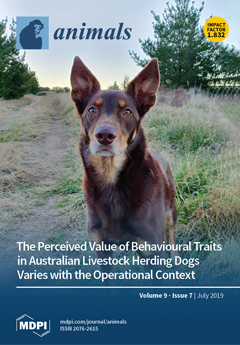Ewes receive hay or graze on fresh pastures supplemented with concentrates to fulfil their lactation requirements. Quebracho (
Schinopsis balansae) can be added to change the ruminal fermentation. Fermentation parameters of forages alone and 70:30 forage:concentrate diets with control and quebracho concentrate
[...] Read more.
Ewes receive hay or graze on fresh pastures supplemented with concentrates to fulfil their lactation requirements. Quebracho (
Schinopsis balansae) can be added to change the ruminal fermentation. Fermentation parameters of forages alone and 70:30 forage:concentrate diets with control and quebracho concentrate were compared after 24 h of in vitro incubation. Fresh forage diets produced less gas (
p < 0.05) and had greater IVOMD (
p < 0.001), ammonia (NH
3-N) content, valeric acid, branched-chain volatile fatty acid proportions, and lower propionic acid proportion than the hay diets (
p < 0.01). In the hay diets, methane production increased with control concentrate (
p < 0.01) and tended to decrease with quebacho concentrate (
p < 0.10). The inclusion of both concentrates increased the acetic:propionic ratio (
p < 0.01), and only the inclusion of quebracho concentrate increased the IVOMD (
p < 0.01). In the fresh forage diets, gas and methane production increased with the inclusion of the control concentrate (
p < 0.05), but methane production decreased with quebracho concentrate (
p < 0.01). The inclusion of quebracho concentrate reduced the NH
3-N content and valeric acid proportion (
p < 0.05). In conclusion, the inclusion of quebracho concentrate would be advisable to reduce the CH
4 production and NH
3-N content in fresh forage diets and to increase the IVOMD in hay diets in comparison with the forages alone.
Full article






